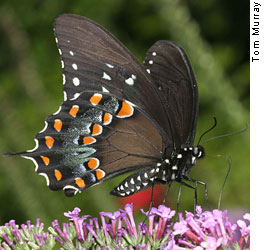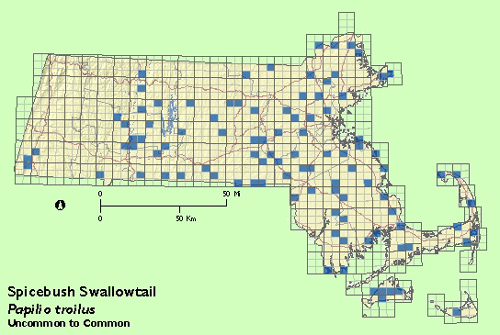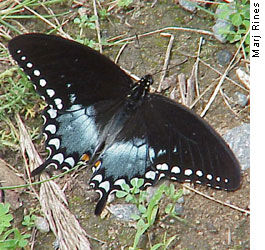Butterfly Atlas
Find a Butterfly
Spicebush Swallowtail
Papilio troilus
Named
Linnaeus, 1758

Identification
Wingspan: 3 1/2 - 4 3/4". Superficially similar to Black Swallowtail (P. polyxenes), the other commonly observed dark swallowtail in Massachusetts. However, readily distinguished by checking the orange pair of spots on the inside corner of the hind wing (visible both above and below). In Black Swallowtail, this spot has a black center; in Spicebush it is clear orange. Marginal spots along fore and hind wings above are whitish to pale blue-gray in Spicebush; yellow in Black. Male Black Swallowtails have a bold yellow submarginal band across both fore and hind wings, which Spicebush never shows. The hind wings of male Spicebush above are a distinctive grayish or greenish blue, never present in Black.
Distribution
Central and Eastern United States from Iowa and the southern Great Lakes region east to southern Maine and south to Florida and central Texas. In New England from southern Maine, New Hampshire, and Vermont south.
Status in Massachusetts
Fairly common to uncommon. Atlas data indicate that this species is widespread in Massachusetts, especially in the eastern and central portions of the state. A relative paucity of Atlas records for Berkshire County indicate that Spicebush Swallowtail is scarce or perhaps rare in the far western portion of the state; this is somewhat at variance with Scudder‘s characterization of this butterfly as "not an uncommon species . . . even in Berkshire Co. Mass.". Farquhar, too, called the species "not uncommon". Maxima: 25, Francis Crane WMA, Falmouth (Barnstable Co.), 13 July 1994.

Flight Period in Massachusetts
Two flight periods: from mid May through late June and early July through late August. Extreme dates: 4 May 1991, BMBS (Worcester Co.), T. Dodd, and 18 September, 1994, Deerfield (Franklin Co.), D. Potter.
Larval Food Plants
Spicebush (Lindera benzoin) and Sassafras (Sassafras albidum).
Adult Food sources
Noted nectaring at 15 species of plants during the Atlas period.

Habitat
Open woodlands, woodland edges, and fields and meadows in proximity to wooded habitats.
Life Cycle
EGG: Pale green; dome shaped. OVIPOSITION: Eggs laid singly on undersurface of hostplant foliage. LARVA: Green above and grayish below with yellow lateral band; six rows of black rimmed, blue spots; two sets of black rimmed, orange blotches forward, the larger, eyespot markings enclosing black, pupil like areas. Fork shaped osmetaria extruded from "neck" area. Larvae remain in foliage shelter consisting of rolled and/or folded, silk sewn leaves during the day; they leave these shelters only under cover of darkness, when most feeding occurs. CHRYSALIS: Yellowish green to pale tan; angular with projections at top; often found close to ground. OVERWINTERING STAGE: Chrysalis.
Soon after emergence, patrolling males may be found in open woodlands and along woodland edges. Males are also noted at mud puddles and, along with females, at various nectar sources.
Account Author
Richard K. Walton



